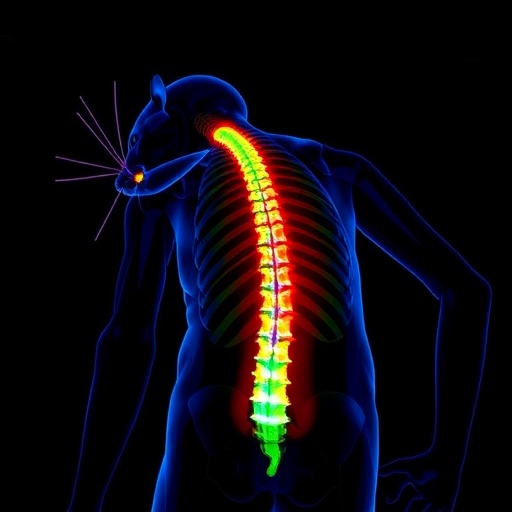In a groundbreaking study, researchers have identified a novel therapeutic application for Pyrroloquinoline quinone (PQQ), a naturally occurring compound known for its antioxidant properties. The research team, led by Geng et al., focused on the implications of PQQ for addressing the challenges posed by senescent osteoclasts—cells that are pivotal in bone resorption and frequently implicated in the pathogenesis of various skeletal disorders, particularly in the context of chronic spinal pain and degeneration.
The context of this research is rooted in the complex interplay of cellular aging and skeletal health. With age, osteoclast functionality can become impaired, leading to an imbalance in bone remodeling processes. As osteoclasts contribute to the degradation of bone tissue, their senescence can result in a myriad of problems, including heightened pain and increased likelihood of degenerative diseases, exacerbating conditions such as spinal pain. The research thoroughly investigates how PQQ can ameliorate these issues, presenting a promising avenue for therapeutic intervention.
The study employed a murine model, specifically designed to replicate lumbar spine instability—an experimental approach that mirrors degenerative disc disease observed in humans. By utilizing this model, researchers were able to precisely observe the effects of PQQ on spinal morphology, pain responses, and cellular activity within the osteoclast population. Notably, the findings highlight how PQQ specifically targets senescent osteoclasts, enabling enhanced bone health and reduced spinal pain.
Along with its primary pain-relieving properties, PQQ has also shown a capacity to reduce endplate degeneration—a crucial aspect of intervertebral disc health. The degeneration of endplates can lead to a compromised disc environment, contributing to pain and mobility issues. By addressing this degeneration, PQQ appears to hold dual benefits: reducing immediate pain and also mitigating long-term structural changes in the spine.
The results were compelling. PQQ administration led to significant reductions in both pain behaviors and histological indicators of degeneration in the spinal structures of the mice. Pain assessments revealed a notable improvement in mobility, highlighting the potential of PQQ as an effective analgesic agent. The researchers meticulously documented these developments, establishing a clear correlation between PQQ treatment and the enhancement of spinal health.
One of the remarkable aspects of this study is the exploration of molecular mechanisms underlying PQQ’s effects. By promoting autophagy—a cellular process crucial for clearing damaged cells and proteins—PQQ seems to reinvigorate senescent osteoclasts, allowing for normal bone resorption and remodeling processes to resume. This insight into PQQ’s mode of action offers exciting possibilities for its use beyond spinal health; it may have implications for various age-related bone disorders.
Furthermore, the implications of this study extend well into potential clinical applications. If similar effects can be confirmed in human clinical trials, PQQ could represent a paradigm shift in the treatment of chronic pain associated with osteoclast activity and age-related degeneration. The need for effective alternatives to current pain management strategies—particularly in light of the opioid crisis—makes this research not only timely but also critical in the search for safer and more effective treatments.
The promising findings surrounding PQQ raise many questions regarding optimal dosing, delivery mechanisms for therapeutic use, and potential side effects. Future research will need to address these factors comprehensively to fully realize the therapeutic potential of PQQ. Insights from the current study serve as a foundation for subsequent investigations and highlight the importance of translational research in addressing pressing health issues.
Moreover, the integration of PQQ into broader pain management protocols and skeletal health strategies may provide novel avenues for collaboration among medical researchers, clinicians, and pharmaceutical developers. The interdisciplinary approach necessary for exploring the multifaceted aspects of PQQ’s effects could catalyze innovative treatment frameworks that bridge laboratory findings with clinical practice.
As the scientific community continues to unveil the myriad complexities of osteoclast biology and aging, studies like this reinforce the value of exploring natural compounds such as PQQ. By adopting a holistic perspective that considers cellular health alongside pain management, researchers can strive toward more comprehensive solutions that enhance patient quality of life.
In conclusion, the investigation into Pyrroloquinoline quinone represents a significant advancement in our understanding of osteoclasts and their role in spinal health. With its demonstrated ability to target senescent cells and improve functional outcomes, PQQ may soon emerge as a key player in therapeutic interventions for spinal pain and degenerative skeletal conditions. As we await further results from ongoing research, the scientific community remains optimistic about PQQ’s potential in revolutionizing the management of age-related bone health issues.
In summary, the transformative potential of PQQ in managing spinal pathology underscores the need for continued research and clinical trials to validate these findings in human populations. The quest for innovative, non-invasive therapies to combat chronic pain and enhance quality of life remains urgent, and PQQ may represent a promising new ally in that endeavor.
Through this exploration, Geng et al. have not only illuminated the critical link between osteoclast senescence and spinal health but have also provided a roadmap for future research that could fundamentally alter therapeutic approaches in orthopedics and gerontology. As we look to the future, the collaborative endeavors of scientists worldwide will undoubtedly be pivotal in translating these exciting findings from the bench to the bedside.
Subject of Research: Pyrroloquinoline quinone’s effect on senescent osteoclasts in relation to spinal health and pain management.
Article Title: Pyrroloquinoline quinone targets senescent osteoclasts and reduces spinal pain and endplate degeneration in a lumbar spine instability mouse model.
Article References:
Geng, Q., Geng, Y., Heng, K. et al. Pyrroloquinoline quinone targets senescent osteoclasts and reduces spinal pain and endplate degeneration in a lumbar spine instability mouse model.
J Transl Med 23, 1119 (2025). https://doi.org/10.1186/s12967-025-07212-9
Image Credits: AI Generated
DOI: 10.1186/s12967-025-07212-9
Keywords: Pyrroloquinoline quinone, osteoclasts, spinal health, senescence, chronic pain, lumbar spine instability, endplate degeneration, bone remodeling.




